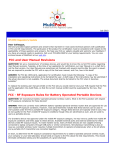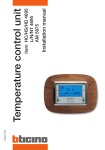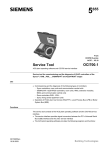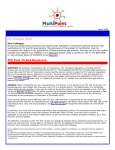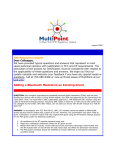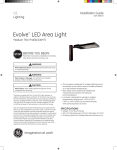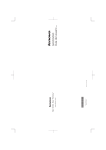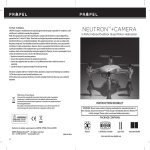Download MultiPoint
Transcript
June 2009 RF/EMC Regulatory Update Dear Colleague, We have provided typical questions and answers that represent in most cases technical opinions with justification in FCC and CE requirements. The particulars of the product for certification must be considered with respect to the applicability of these questions and answers. We hope you find our update valuable and welcome your feedback if you have any special needs or questions. Call us at 703-689-0368 for your testing requirements. You can view archived issues of MultiPoint at our web site. FCC Permissive Change Rules QUESTION: Our test lab informed us that the FCC has specific polices on Permissive Changes, can you explain? ANSWER: FCC Section 2.1043 states that change to the basic frequency determining and stabilizing circuitry (including clock or data rates), frequency multiplication stages, basic modulator circuit or maximum power or field strength ratings require a new FCC a new grant of certification. Other variations in electrical or mechanical construction, other than the aforementioned are allowed provided the variations in EMI profile either does not affect the data required to be reported to the FCC or the variations are made in accordance with three classes of Permissive Changes permitted under its rules and regulation. One exception to this rule is for changes to the software installed in a transmitter that do not affect the radio frequency emissions. Such changes do not require a filing with the FCC and may be made by parties other than the holder of the grant of certification. The three classes are of Permissive Changes are: • • • Class I Permissive Change: modifications in the equipment that do not degrade the characteristics reported by the manufacturer. Class II Permissive Change: modifications which degrade the performance characteristics as reported to the FCC at the time of the initial certification. Class III Permissive Change: modifications to the software of a software defined radio transmitter that changes the frequency range, modulation type or maximum output power (either radiated or conducted) outside the parameters previously approved, or that change the circumstances under which the transmitter operates in accordance with FCC. However, a recent FCC policy document, 178919 D01 Permissive Change Policy v04r03, specifically addresses antenna changes, PCB and hardware changes, enclosure changes, software changes, and other miscellaneous changes. Please see link for the document. FCC Rules 802.11b/g and UNII QUESTION: We manufacture Part 15 802.11b/g and UNII transmitters. Are we allowed, as a manufacturer, to configure our Part 15 transmitter 802.11b/g and UNII devices to allow end-users or professional installers to set the country code to ensure compliance if the user manual contains the following statement: " WARNING: Select only the country in which you are using the device. Any other selection will make the operation of this device illegal"? ANSWER: No. The FCC does not allow such a configuration. A Part 15 device is not allowed to have the ability to be configured by end users or professional installers to operate any other way except as granted. Selecting county codes or country specific frequencies, power or grant conditions for different regulatory domains are not permitted as required in Section 15.202 of the rules. All master devices, as defined in 15.202, must operate within the authorized bands and cannot have the ability to be configured for other countries. All devices meeting the definition of a client, as specified in 15.202, may have the ability to operate on other regulatory domain frequencies if it is under (automatically associates with) control of a certified master device. In this situation, the WARNING statement mentioned above would not serve any purpose since frequency selection, power or grant conditions would be automatic and regulatory domain selection would not be permitted. Many devices, referred to by the Wi-Fi industry as client devices, may not meet the definition of a 15.202 client and must be limited to operate as master devices on US frequencies and within the grant conditions. To qualify as a 15.202 client, a device cannot initiate or be configured to initiate any transmission for any reason on non-US frequencies or on frequencies not granted. This includes probes, beacons and ad hoc mode transmissions. Only if all features and functions that utilize initiating transmissions are within the US frequencies as granted, then the device could be granted as a 15.202 client device. These devices could then have the capability to automatically associate and operate on non-US frequencies when outside of the US under the control of a foreign master device authorized on other regulatory domain frequencies. EU Test Report Requirements QUESTION: Our firm manufactures and sells CDMA cell phones. Recently, we were informed by our new Notified Bodies (NB) that our CE RF reports require data to sufficiently demonstrate compliance. Typically, we have provided reports to our NB without any data, but rather a pass attestation for each parameter tested as required by the particular applicable standard. Can you shed some light on this issue? ANSWER: More recently, some Notified Bodies (NB) are asking for more test data to be included in the reports. In general, it is very good practice to include at least minimum-test-item results such as max power, bandwidth and max radiated spurious emission measurements, etc. This is typically not an extreme amount of data. Please remember that an NB opinion is not an opinion that takes "PASS" as proof, but is the evaluation of a NB on testing according to the proposed test suite. In fact, all NBs should insist on it for all technologies including mobile phones. Although mobile phones can produce high amounts of test data results because of the various modes they support, it is always desirable to include in your test reports the aforementioned minimum test results. Presently time, there is a lot of talk in the European Commission about the effectiveness of all European compliance, mostly because the market surveillance work has found many non-compliant products on the market. Some are calling for much stricter control. For this reason, it is very likely that the whole R&TTE Directive will be re-written, the compliance process for Europe may change and the role of the Notified Body may also change. It is likely that some Notified Bodies, who are not asking for these minimum test results included in your reports presently, will start asking for it; furthermore, many manufacturers and labs will have to make more efforts in providing these test data results in their test reports. Although this is all in the future, we do know that the European Commission is gathering information now and looking at the entire European compliance program. We believe it will become even more important for test labs to present more test data to demonstrate compliance, and to use for comparisons during market surveillance. In our various informal discussions with representatives of the European Commission we have been told that test reports should contain all test results, not just a pass or fail statement, so this could be something they are looking at to enhance the CE program. This June, there is a meeting in Europe to discuss the future of the R&TTE Directive and the future CE Mark process. We believe this topic will be of interest, and we will keep you and our readers up to date with the latest information. FCC Approval of DFS Devices QUESTION: Is the FCC presently granting approvals of master Dynamic Frequency Selection (DFS) devices? ANSWER: Previously, the FCC performed 100% full DFS sample device testing prior to issuing approval grants. On June 10, 2009, during a regular conference call with the TCB Council Membership, the FCC announced that NTIA is currently investigating interference with UNII Master Devices and as a result, the FCC is halting the issue of new Certifications of master DFS devices until further notice. The UNII band operates in the same spectrum space as many government radars. The purpose of the DFS function in the 5250-5350 and 5470-5725 MHz bands is to detect and avoid frequencies where government services are operating. Apparently, there are some concerns with actual implementation of the methods to avoid interference INTERNATIONAL UPDATE EU: NEW CENELEC STANDARDS RECENTLY RELEASED This is a shortened list of the CENELEC standards published during the past month: • • • • • • • • • • • • • • EN 60068-2-27:2009 (5/7/2009) Environmental testing -- Part 2-27: Tests - Test Ea and guidance: Shock EN 55014-1:2006/A1:2009 (5/7/2009) Electromagnetic compatibility - Requirements for household appliances, electric tools and similar apparatus -- Part 1: Emission EN 61000-4-27:2000/A1:2009 (5/7/2009) Electromagnetic compatibility (EMC) -- Part 4-27: Testing and measurement techniques - Unbalance, immunity test for equipment with input current not exceeding 16 A per phase EN 61000-4-28:2000/A2:2009 (5/7/2009) Electromagnetic compatibility (EMC) -- Part 4-28: Testing and measurement techniques - Variation of power frequency, immunity test for equipment with input current not exceeding 16 A per phase EN 60745-2-1:2003/A1:2009 (5/13/2009) Hand-held motor-operated electric tools - Safety - Part 2-1: Particular requirements for drills and impact drills EN 60598-1:2008/A11:2009 (5/14/2009) Luminaires -- Part 1: General requirements and tests EN ISO/IEC 17030:2009 (5/20/2009) Conformity assessment - General requirements for third-party marks of conformity EN 60601-2-2:2009 (5/20/2009) Medical electrical equipment -- Part 2-2: Particular requirements for the basic safety and essential performance of high frequency surgical equipment and high frequency surgical accessories EN 60099-4:2004/A2:2009 (5/29/2009) Surge arresters -- Part 4: Metal-oxide surge arresters without gaps for a.c. systems EN 50131-4:2009 (6/4/2009) Alarm systems - Intrusion and hold-up systems -- Part 4: Warning devices EN 60947-5-1:2004/A1:2009 (6/5/2009) Low-voltage switchgear and controlgear -- Part 51: Control circuit devices and switching elements - Electromechanical control circuit devices EN 62026-3:2009 (6/11/2009) Low- voltage switchgear and controlgear - Controller-device interfaces (CDIs) -- Part 3: DeviceNet EN 62430:2009 (6/11/2009) Environmentally conscious design for electrical and electronic products EN 50428:2005/A2:2009 (6/17/2009) Switches for household and similar fixed electrical installations - Collateral standard - Switches and related accessories for use in home and building electronic systems (HBES) See CENELEC for additional information. EU: NEW IEC STANDARDS RECENTLY RELEASED This is a shortened list of the new IEC standards published during the past month: • • • • • • • • • • • • • IEC 62153-4-10 (5/13/2009) Metallic communication cable test methods - Part 4-10: Electromagnetic compatibility (EMC) - Shielded screening attenuation test method for measuring the screening effectiveness of feed- throughs and electromagnetic gaskets double coaxial method IEC 61000-4-13-am1 (5/13/2009) Amendment 1 - Electromagnetic compatibility (EMC) - Part 4-13: Testing and measurement techniques - Harmonics and interharmonics including mains signalling at a.c. power port, low frequency immunity tests IEC 61000-4-34-am1 (5/13/2009) Amendment 1 - Electromagnetic compatibility (EMC) - Part 4-34: Testing and measurement techniques - Voltage dips, short interruptions and voltage variations immunity tests for equipmentwith mains current more than 16 A per phase IEC 61000-4-14-am2 (5/13/2009) Amendment 2 - Electromagnetic compatibility (EMC) - Part 4-14: Testing and measurement techniques - Voltage fluctuation immunity test for equipment with input current not exceeding 16 A per phase IEC 62320-1 (5/27/2009) Maritime navigation and radiocommunication equipment and systems Automatic identification system (AIS) - Part 1: AIS Base Stations - Minimum operational and performance requirements, methods of testing and required test results CISPR 11 (5/28/2009) Industrial, scientific and medical equipment - Radio-frequency disturbance characteristics - Limits and methods of measurement IEC 62386-205 (6/9/2009) Digital addressable lighting interface - Part 205: Particular requirements for control gear - Supply voltage controller for incandescent lamps (device type 4) IEC 62386-201 (6/10/2009) Digital addressable lighting interface - Part 201: Particular requirements for control gear - Fluorescent lamps (device type 0) IEC 62386-206 (6/10/2009) Digital addressable lighting interface - Part 206: Particular requirements for control gear - Conversion from digital signal into d.c. voltage t IECEE ROHS-DB-12M (6/11/2009 IECEE CB BULLETIN - Information about IEC Standards and National Differences operated by the IECEE Members to issue IEC 60059-am1 (6/16/2009) Amendment 1 - IEC standard current ratings IEC 60335-2-24 Corr.1 (6/16/2009) Corrigendum 1 - Household and similar electrical appliances Safety - Part 2-24: Particular requirements for refrigerating appliances IEC 60196 (6/17/2009) IEC standard frequencies See IEC for additional information. EU: NEW ETSI STANDARDS RECENTLY RELEASED This is a shortened list of the new ETSI standards published during the past month: • • • • • • • ETSI EN 301 489-4 V1.4.1 (May 2009) Electromagnetic compatibility and Radio spectrum Matters (ERM); ElectroMagnetic Compatibility (EMC) standard for radio equipment and services; Part 4: Specific conditions for fixed radio links, Broadband Data Transmission System Base stations, ancillary equipment and services ETSI EN 301 489-17 V2.1.1 (May 2009) Electromagnetic compatibility and Radio spectrum Matters (ERM); ElectroMagnetic Compatibility (EMC) standard for radio equipment; Part 17: Specific conditions for Broadband Data Transmission Systems ETSI EN 300 065-2 V1.2.1 (May 2009) Electromagnetic compatibility and Radio spectrum Matters (ERM); Narrow-band direct-printing telegraph equipment for receiving meteorological or navigational information (NAVTEX); Part 2: Harmonized EN covering the essential requirements of article 3.2 of the R&TTE directive ETSI EN 300 065-3 V1.2.1 (May 2009) Electromagnetic compatibility and Radio spectrum Matters (ERM); Narrow-band direct-printing telegraph equipment for receiving meteorological or navigational information (NAVTEX); Part 3: Harmonized EN covering the essential requirements of article 3.3 (e) of the R&TTE directive ETSI TR 102 496 V2.1.1 (May 2009) Electromagnetic compatibility and Radio spectrum Matters (ERM); System Reference Document; Short Range Devices (SRD); Technical characteristics for Location tracking Applications for Emergency Services (LAES) in disaster situations operating within the frequency range from 3,4 GHz to 4,8 GHz ETSI TR 102 834 V1.1.1 (May 2009) Electromagnetic compatibility and Radio spectrum Matters (ERM); System Reference Document; Technical Characteristics for airborne Ultra-WideBand (UWB) applications operating in the frequency bands from 3,1 GHz to 4,8 GHz and 6 GHz to 8,5 GHz ETSI TR 102 763 V1.1.1 (June 2009) Electromagnetic compatibility and Radio spectrum Matters (ERM) Short Range Devices (SRD); Technical characteristics of Detect-And-Avoid (DAA) mitigation techniques for SRD equipment using Ultra Wide Band (UWB) technology See new ETSI website for additional information. CANADA: RELEASE OF NEW ISSUES Industry Canada has recently released several new radio standards issues. Please see below for additional detail: On May 30, 2009, Industry Canada released Notice SMSE-002-09 - DC-01, Issue 3: Procedure for Declaration of Conformity and Registration of Terminal Equipment. Changes in the new issue include: • • • clarification of the registration process for handset telephones (see section 1.2) subject to the requirements of Compliance Specification (CS-03), Part V; clarification of the concepts of Multiple Listing and Transfer of Ownership, sections 6.7 and 6.8 respectively; and addition of a new audit requirement affecting Canadian representatives of Declaring Parties, section 7.3. Link On May 30, 2009, Industry Canada released Amendment 4 to Issue 9 of Compliance Specification (CS-03), Part VIII. Changes in the new amendment include: • • • • • • • • addition of harm prevention criteria for VDSL2 equipment using profiles 8a, 8b, 8c, 8d, 12a, 12b, 17a and 30a for operation over POTS and All Digital Mode; deletion of old Table 3.4(b): Transverse Balance Testing Criteria; addition of new tables specifying the frequency range of transverse balance requirements for the various xDSL interfaces; deletion of Table 3.5: Maximum Longitudinal Output Voltage Limit; addition of requirements for maximum LOV for VDSL2 terminal equipment (see Tables 3.5(a): Maximum Longitudinal Output Voltage limit for VDSL2 terminal equipment, and 3.5(b): Values of fb for various VDSL2 upstream PSD masks); addition of requirements for maximum LOV for technologies other than VDSL2 (see Tables 3.5(c): Maximum Longitudinal Output Voltage (LOV) for technologies other than VDSL2, and 3.5(d): Values of fb for various all digital mode extended upstream PSD masks); technical and editorial changes affecting some PSD mask definitions (see Tables 3.2.1.1; 3.2.1.2; 3.2.1.3(a); 3.2.1.3(b); 3.2.1.4(a); 3.2.1.4(b); 3.2.1.5(a); 3.2.1.5(b); 3.2.1.8(a) and 3.2.1.9(a)); and deletion of sections 3.2.1.6: ATU-R PSD Mask Definition (ADSL2+ with Extended Downstream Above POTS); and 3.2.1.7: ATU-R PSD Mask Definition (ADSL2+ All Digital Mode). Link On June 6 ,2009, Industry Canada released Interference-Causing Equipment Standards 006 (ICES-006), Issue 2: AC Wire Carrier Current Devices (Unintentional Radiators), which sets out limits and method of measurement of radio noise emissions and specifies maximum permissible output voltages from AC wire carrier current devices of a design for which radiation of radio frequency energy is unintentional. Listed below are the main changes: • • • Section 2: The definition of in-house BPL has been added. Section 4.3: Additional in-situ testing requirements have been added. Section 5.3.1: Radiated field strength limits (Table 3) have been extended to cover devices operating above 30 MHz. Link On June 6 ,2009, Industry Canada released Interference-Causing Equipment Standards 005 (ICES-005), Issue 3, Radio Frequency Lighting Devices (RFLDs), which sets the technical requirements relative to the radiated and conducted radio noise emissions from radio frequency lighting devices (RFLDs). Changes were made to Section 4.3.2: The frequency ranges of measurement of radiated emissions were extended to cover different operating frequency bands. Link On June 13, 2009, Industry Canada released Notice No. SMSE-001-09 which announced new Issues of RSS-111, RSS-135 and RSS-215, as well as the withdrawal of RSS-128. The documents were updated as follows: • • Radio Standards Specification 111 (RSS-111), Issue 3: Broadband Public Safety Equipment Operating in the Band 4940-4990 MHz, which sets certification requirements for radio transmitters and receivers in this band for public safety applications - the main change was the establishment of the maximum channel bandwidth of 20 MHz; Radio Standards Specification 135 (RSS-135), Issue 2: Digital Scanner Receivers, which sets certification requirements for digital scanner receivers - the main change was the spurious emission limits for receivers • is now specified and referred to RSS-Gen ; and Radio Standards Specification 215 (RSS-215), Issue 2: Analogue Scanner Receivers, which sets certification requirements for analogue scanner receivers - the main change is the spurious emissions limit (using the radiated measurement method) for receivers at frequencies above 1610 MHz has been removed. The 960-1610 MHz limit is now applicable to all receiver spurious emissions at frequencies above 960 MHz, as per RSS-Gen. Notice is also given that Industry Canada is withdrawing the following document: • Radio Standards Specification 128 (RSS-128), Issue 2, Revision 1: 800 MHz Dual-Mode TDMA Cellular Telephones. RSS-128 is rescinded because the Time Division Multiple Access (TDMA) IS-136 standard is no longer used in Canada. The Global System for Mobile (GSM) communication standard is covered in RSS-132, Cellular Telephones Employing New Technologies Operating in the Bands 824-849 MHz and 869-894 MHz. US : CPS TRACKING LABEL REQUIREMENT On August 14, 2009, under the US Consumer Product Safety Improvement Act of 2008 (CPSIA), a tracking label requirement will goes into effect requiring children's products and their packaging must include permanent labels that identify the source, production date and batch information to enable efficient identification of recalled products. The requirement specifies the manufacturer of a children's product shall place permanent, distinguishing marks on the product and its packaging, to the extent practicable, that will enable (a) the manufacturer to ascertain the location and date of production of the product, cohort information (including the batch, run number, or other identifying characteristic), and any other information determined by the manufacturer to facilitate ascertaining the specific source of the product by reference to those marks; and (b) the ultimate purchaser to ascertain the manufacturer or private labeler, location and date of production of the product, and cohort information (including the batch, run number, or other identifying characteristic). Link JAPAN: NEW VCCI LABEL REQUIREMENTS As of April 1, 2009, Japan's VCCI became VCCI Council and has new labeling requirements for the VCCI Mark. The new labels may be downloaded from VCCI's website and it is suggested the new labels be used from April 1, 2009 forward. However, there is a one year grace period and the older VCCI labels are allowed to be used for all applications submitted on or before March 31, 2010. Link KOREA: MANDATORY CERTIFICATION OF LITHIUM BATTERIES From July 1, 2009, lithium secondary cells and batteries for use in portable electrical equipment are required to be certified under the Korean safety certification (KC) scheme for consumer products. This mandatory lithium battery certification is aimed at preventing the risk of explosion or fire. The certification is required for portable lithium secondary cell with power density of more than 400Wh/h and batteries (packs) made from cells. Excluded from the requirement are batteries used in automobile, industrial, or medical applications. The new safety requirements include high temperature testing, extermal short circuit testing, thermal abuse testing, and crush testing. CONTACT RHEIN TECH FOR YOUR INTERNATIONAL REGULATORY APPROVALS Rhein Tech Laboratories' worldwide homologation services offer the best strategy for gaining product approval in a large number of target countries. In addition, we reduce the number of emissions, immunity, and product safety tests required by defining the minimum subset of regulatory standards at the onset, thus reducing the time and cost to enter multiple target countries. We offer research and approvals in over 50 countries. ... . ABOUT US RTL has provided EMC compliance engineering & testing services since 1988 and has a superior reputation with both the Federal Communications Commission and others in the industry. RTL provides testing services to meet the emissions, immunity, and safety requirements of the European EMC Directive and the EU R&TTE Directive, all FCC rules and regulations, VCCI (Japan), ACMA (Australia), and other international standards. A special thank you to those who have recommended and contributed articles for our newsletter. Please continue to forward new and interesting material to our attention: [email protected]. We respect the privacy of our customers and colleagues. If you would like to cancel your MultiPoint updates, please follow the instructions at the end of this email. The information in the MultiPoint update is subject to change without notice. Learn More email: [email protected] phone: 703-689-0368 web: http://www.rheintech.com Last revised: June 18, 2009







